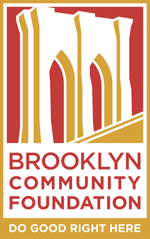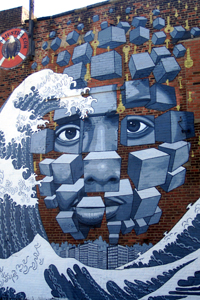 “Do Good Right Here” is a deceptively simple notion with huge implications, now being put forth by the Brooklyn Community Foundation. The motivation is simple: to make Brooklyn better, because even with the buzz, the brand, and all the new buildings, our borough is also a leader in poverty, unemployment, school drop-outs, hunger, and other areas its boosters might prefer to overlook.
“Do Good Right Here” is a deceptively simple notion with huge implications, now being put forth by the Brooklyn Community Foundation. The motivation is simple: to make Brooklyn better, because even with the buzz, the brand, and all the new buildings, our borough is also a leader in poverty, unemployment, school drop-outs, hunger, and other areas its boosters might prefer to overlook.
Three years ago, a group of Brooklynites working in philanthropy developed the plan for the first-ever foundation for Brooklyn. Acting on a study from the Foundation Center that determined nearly 90% of all grants made by private foundations in New York went to Manhattan-based groups, these organizers decided that Brooklyn’s 2.5 million residents needed a “community foundation” — a century-old model for philanthropy designed to help donors support local solutions to local challenges.
Brooklyn’s giving legacy has deep roots. It’s home to the nation’s first children’s museum, first performing-arts center, and first community development corporation.

The same spirit is very much alive today, as Brooklyn has nurtured the naissance of new nonprofit models such as the Bed-Stuy Coalition Against Hunger, Added Value Community Farm, Brooklyn Workforce Innovations, Groundswell Community Mural Project, ReelWorks Teen Filmmaking, and the Willie Mae Rock Camp for Girls.
With government resources tightening and increasingly uneven support from foundations across the river, there was no guarantee that Brooklyn’s future would live up to the ambitions of its past. Thus, the Brooklyn Community Foundation was created to help residents collectively invest their resources in taking on the borough’s considerable challenges.
“Brooklyn is now home to more people with college degrees than Boston, and more wealth than Greenwich, Conn.,” BCF President Marilyn Gelber said. “Yet we’ve got a higher percentage of people living in poverty than Baltimore, and our food-stamp recipients outnumber the entire population of Washington, D.C. Something has to be done to bridge this divide, and it must be done with urgency.”

Three years in, the foundation has made more than $10 million in grants to hundreds of Brooklyn-based, neighborhood-focused nonprofits working in community development, human services, the environment, education, and the arts. “Our donors support our approach because they recognize how extraordinary our communities are, and that the most effective solutions often come from within,” Gelber noted. “They believe in backing next generation leadership, new ideas, and fresh approaches that react quickly to trends. Our philosophy is for Brooklyn, by Brooklyn.”
But it’s more than just about the grants, she added. “We are here to tell the complete Brooklyn story. We want to celebrate our communities, the nonprofits that serve them, and build sustainable support and growth on all levels. We’re counting on the next generation of Brooklyn philanthropists to take up our cause and do good right here.”
Learn more about the Brooklyn Community Foundation and its campaign for Brooklyn’s future at www.brooklyncommunityfoundation.org.
from the Summer 2012 Civic News

